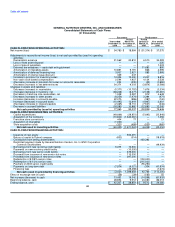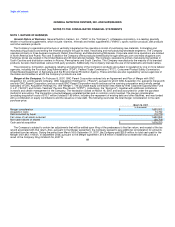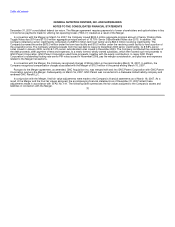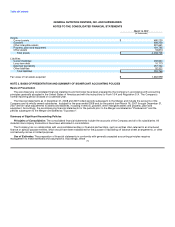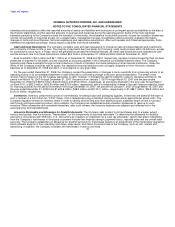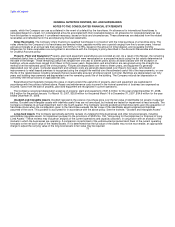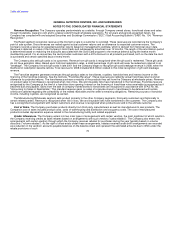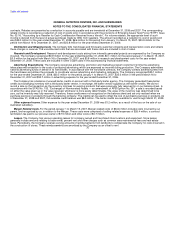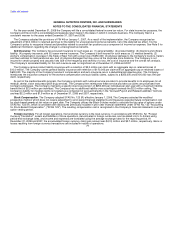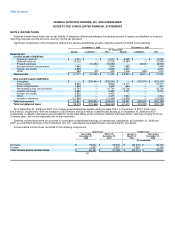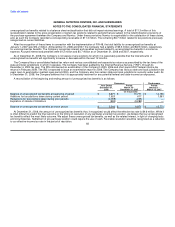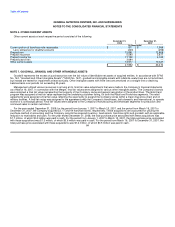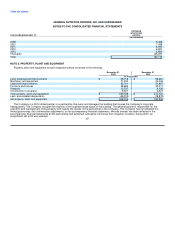GNC 2009 Annual Report Download - page 84
Download and view the complete annual report
Please find page 84 of the 2009 GNC annual report below. You can navigate through the pages in the report by either clicking on the pages listed below, or by using the keyword search tool below to find specific information within the annual report.
Table of Contents
GENERAL NUTRITION CENTERS, INC. AND SUBSIDIARIES
NOTES TO THE CONSOLIDATED FINANCIAL STATEMENTS
Financial Instruments and Derivatives. As part of the Company's financial risk management program, it uses certain derivative financial
instruments. The Company does not enter into derivative transactions for speculative purposes and holds no derivative instruments for trading
purposes. The Company uses derivative financial instruments to reduce its exposure to market risk for changes in interest rates primarily in
respect of its long term debt obligations. The Company tries to manage its interest rate risk in order to balance its exposure to both fixed and
floating rates while minimizing its borrowing costs. To achieve these objectives, the Company primarily uses interest rate swap agreements to
manage exposure to interest rate changes related to its senior credit facility borrowings. These interest rate swap agreements are primarily
designated as cash flow hedges. The Company measures hedge effectiveness by assessing the changes in the fair value or expected future
cash flows of the hedged item. The changes in the fair value of the hedges are reported in other long term assets or liabilities in the
consolidated balance sheet. At December 31, 2007, the Company had interest rate swap agreements outstanding that effectively converted
notional amounts of $300.0 million of debt from floating to fixed interest rates. During the third quarter, the Company entered into two new
forward agreements with start dates of the expiration dates of the pre-existing interest rate swap agreements (April 2009 and April 2010). In
addition, during the third quarter of 2008, the Company entered into a new interest rate swap agreement with an effective date of
September 30, 2008 that effectively converted an additional notional amount of $100.0 million of debt from floating to fixed interest rate. The
outstanding agreements mature between April 2009 and September 2011. The Company would have paid $18.9 million ($12.0 million net of
tax) and $5.6 million ($3.6 million net of tax) at December 31, 2008 and 2007, respectively, to settle the interest rate swap agreements, which
represent the fair value of these agreements. In addition the Company recorded accrued interest of $0.7 million and interest receivable of
$0.2 million, at December 31, 2008 and 2007, respectively, for current amounts due under the agreements.
Recently Issued Accounting Pronouncements.
In September 2006, the Financial Accounting Standards Board, ("FASB") issued Statement of Financial Accounting Standard ("SFAS")
No. 157, "Fair Value Measurements" ("SFAS 157"). SFAS 157 defines fair value, establishes a framework for measuring fair value in generally
accepted accounting principles, and expands disclosures about fair value measurements. SFAS 157 applies under other accounting
pronouncements that require or permit fair value measurements and, accordingly, does not require any new fair value measurements. SFAS
157 was initially effective as of January 1, 2008, but in February 2008, the FASB delayed the effectiveness date for applying this standard to
nonfinancial assets and nonfinancial liabilities that are not currently recognized or disclosed at fair value in the financial statements. SFAS 157
is effective for fiscal years beginning after November 15, 2007, except for nonfinancial assets and liabilities that are recognized or disclosed at
fair value in the financial statements on a nonrecurring basis, for which application has been deferred for one year. The Company adopted
SFAS 157 in the first quarter of fiscal 2008 (See Note 23) for financial assets and liabilities.
In February 2007, the FASB issued SFAS No. 159 "The Fair Value Option for Financial Assets and Financial Liabilities—Including an
amendment of FASB Statement No. 115" ("SFAS 159"). SFAS 159 expands the use of fair value accounting but does not affect existing
standards which require assets or liabilities to be carried at fair value. The objective of SFAS 159 is to improve financial reporting by providing
companies with the opportunity to mitigate volatility in reported earnings caused by measuring related assets and liabilities differently without
having to apply complex hedge accounting provisions. Under SFAS 159, a company may elect to use fair value to measure eligible items at
specified election dates and report unrealized gains and losses on items for which the fair value option has been elected in earnings at each
subsequent reporting date. Eligible items include, but are not limited to, accounts and loans receivable, available-for-sale and held-to-maturity
securities, equity method investments, accounts payable, guarantees, issued debt and firm commitments. SFAS 159 is effective for fiscal years
beginning after November 15, 2007. The adoption of SFAS 159 did not affect the financial statements as the Company did not elect to use the
fair value option. 78


